Succulents are beautiful plants that come in different colors, sizes, shapes, and textures and are guaranteed to brighten up your home and outdoor garden. You can display succulent plants in containers to accent your rock garden, in baskets to adorn your patio, or as ground cover to add color and life to your concrete floor.
Another quality that makes succulents a wonderful choice for your landscape or home is that they are easy to grow and care for. You don’t have to have a green thumb to be successful at growing these highly-durable plants because they don’t need much maintenance.
The Number One Rule in growing succulents is:
Everyday sunshine and water only when the soil is 100% dry.
Some varieties of succulents can pull out a special surprise for you. If you expose them to the rays of the full hot sun, their colors can change!
Best Succulents For Full Hot Sun
All plant life needs the nurturing rays of the sun. Like other plants, succulents use the sun’s rays to produce food.
There are also types of succulents that achieve their full spectrum of colors when given regular sun exposure – assuming more intense hues. In some species, the leaves change color when exposed directly to the sun’s rays.
One thing to remember when giving your wonderful succulents sunlight is to avoid the afternoon sun which can be too intense that its leaves get burned. As durable as these plants are, they’ll thrive when receiving their daily dose of morning sunshine for up to 6 hours.
If your garden has areas that get bright sunlight every day, you might want to grow some of the succulents in our list that do better when under the rays of the full hot sun.
1. Graptopetalum Paraguayense
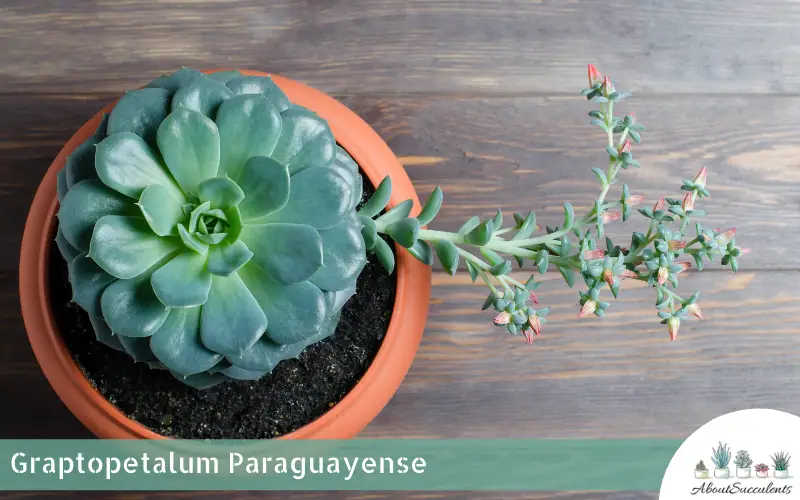
Graptopetalum paraguayense is a charming succulent that only grows to a height of 1 foot (30 cm) but its elegant, flat, and plump leaves form tight, 4-inch (10 cm) rosettes and the plant can spread out as far as 3 feet (90 cm).
Graptopetalum paraguayense’s striking opalescence leaves are the main attraction for horticulturists and plant hobbyists alike. These leaves start out as pale, and grayish-white which gives the succulent its common name, ‘Ghost Plant’.
However, when directly exposed to the bright sun, the leaves’ colors change to pinkish-yellow. In the springtime, you’ll be gifted by Ghost Plant with adorable, star-shaped, and yellow-colored flowers.
2. Echeveria Agavoides ‘Ebony’
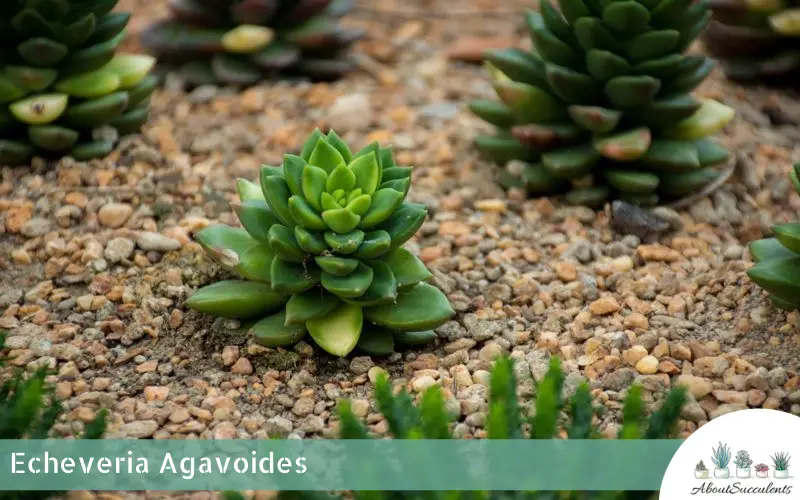
If your garden basks abundantly with sunshine, plant Echeveria agavoides ‘ebony’ in your rock or Mediterranean-themed garden. Watch the red margins on its tips assume a dark chocolate to purple color when exposed to direct sunlight.
Echeveria agavoides ‘ebony’ is a captivating succulent that’s beloved for its fleshy, grayish-green colored, spear-shaped leaves that are accented with bright-red margins at the tips.
Another interesting quality of Ebony is that it can withstand frosty weather conditions. In fact, Ebony will help you usher in the winter months with reddish-pink flowers that have yellow tips.
3. Agave Parryi Truncata
Agave parryi truncata is the ideal succulent to plant in your garden if there are areas that receive bright sun and need more color, texture, and the all-important ‘wow’ factor.
Its common name ‘Artichoke Agave’ is an obvious nod to the popular vegetable and its close appearance is due to its flat, wide, and thick leaves that form tight rosettes. The silvery-blue colored leaves of Artichoke Agave are margined with teeth-like formations that have a reddish-brown hue.
Agave is topped by a flowering spike that reaches a height of 15 feet (5 m) and will blossom with endearing clusters of small, yellow-colored flowers that have an orange bud.
Artichoke Agave will take a long time to produce flowers and ironically, will die a short time after. Fortunately, it will leave you with offsets that you can use to propagate the species.
4. Kalanchoe Luciae
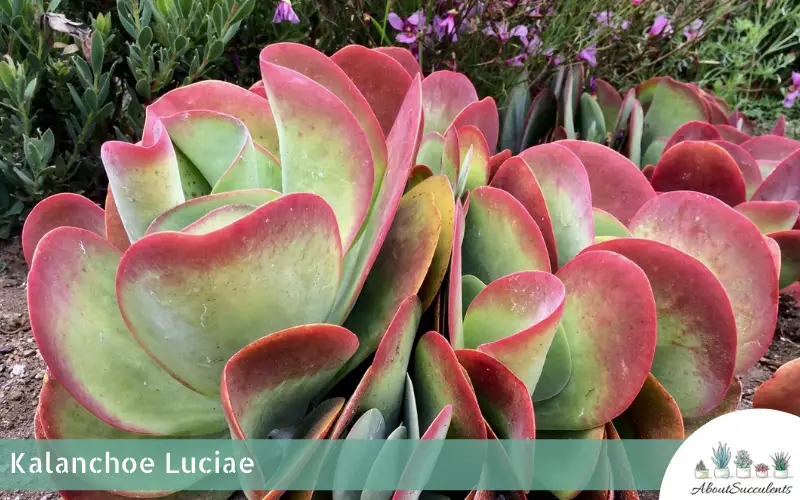
If you want to impress your guests and onlookers, grow Kalanchoe Luciae in your outdoor garden. This magnificent succulent is identifiable by its robust, flat, and clamshell-shaped, green-colored leaves with red tips that form a mesmerizing rosette.
Also known by multiple common names such as ‘Paddle Plant’, ‘Desert Cabbage’, ‘Flapjacks’, and ‘Red Pancakes’, this species of Kalanchoe that received the Award of Garden Merit from the Royal Horticultural Society, grows its deep red tips when exposed to full hot sun.
Wait for late winter or early spring and be greeted by clusters of small, yellow-colored flowers with a tubular shape. Paddle Plant can reach a height of 2 feet (60 cm) and spread as far as 3 feet (90 cm).
5. Crassula Capitella ‘Campfire’
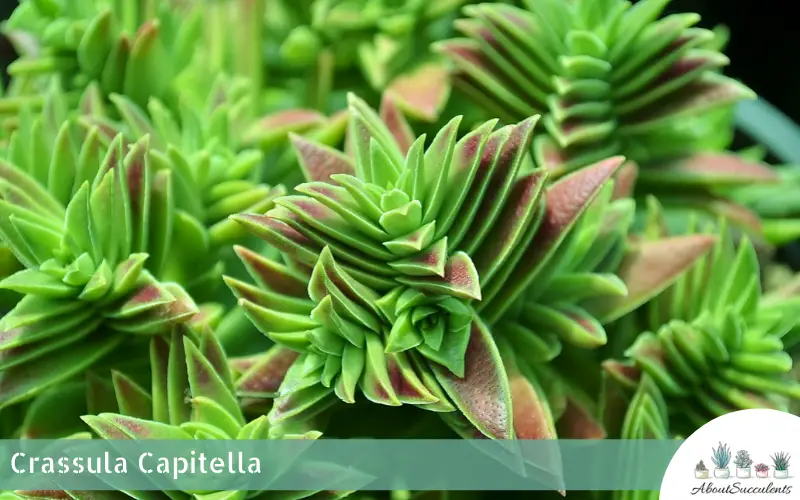
Are you looking for a type of succulent that can be used as ground cover or border for your flower bed? Crassula capitella ‘Campfire’ might fit what you have in mind.
Campfire is an eye-catching, low-growing, and spreading succulent that’s characterized by its densely compact, propeller-like leaves that start out with green colors but turn bright red when directly exposed to sunlight.
In the summertime, your garden will light up even more when Campfire produces clusters of small, white to cream-colored, and star-shaped flowers. Other names for Campfire include Crassula ‘Flame’ and Crassula ‘Blaze’ and it can grow to a height of 6 inches (15 cm) and spread out to 2 feet (90 cm).
6. Sempervivum Arachnoideum
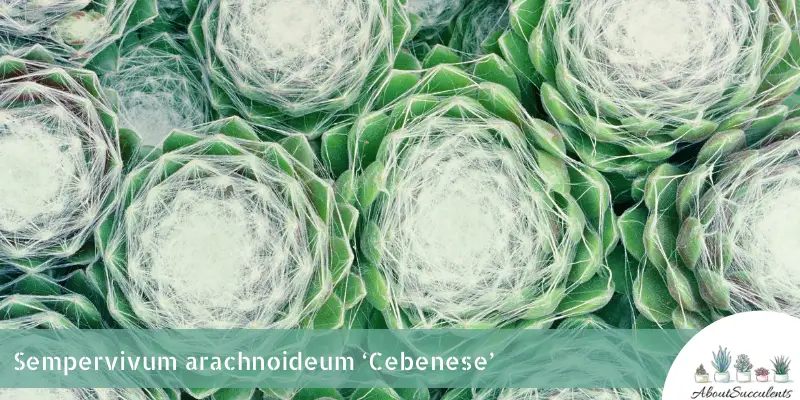
Its scientific name alone gives you an idea of what Sempervivum arachnoideum looks like and why it appeals to so many horticulturists and succulent hobbyists.
The emerald green leaves of Sempervivum arachnoideum form rosettes that spread out to a foot (30 cm). The thick, fleshy leaves are accented by white, hairy textures on their tips that look like cobwebs.
In summer, you’ll notice a thick flowering stalk grow out of Sempervivum from where small, star-shaped, and pink-colored flowers bloom. Sempervivum arachnoideum is a monocarpic succulent which means it will die after producing the flowers.
Not to worry as some of its common names are ‘Cobweb Hens and Chicks’ and ‘Cobweb Houseleek’ which are because Sempervivum arachnoides grows offsets that can be used to propagate the species.
A recipient of the distinguished Award of Garden Merit from the Royal Horticultural Society, Cobweb Hens and Chicks grows better when given full sunlight exposure for up to 6 hours every day.
7. Aeonium ‘Kiwi’
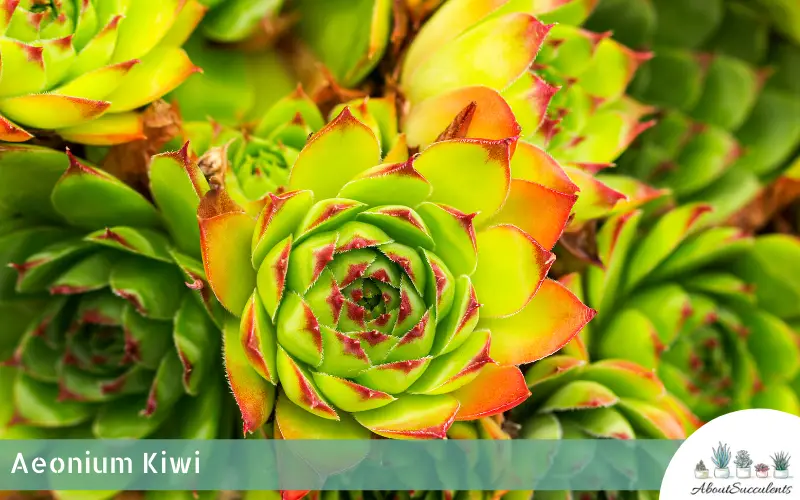
‘Graceful’, ‘stylish’, and ‘elegant’ are just a few of the words used to describe picturesque Aeonium ‘Kiwi’ which are easily recognizable by experienced succulent growers by its spoon-shaped, fleshy, and light greenish-yellow cream-colored leaves.
When exposed to full hot sun, the leaves develop red-tinged tips that make an eye-catching contrast to its colors that appear to cascade to different light shades of green.
Also known as Aeonium decorum ‘Kiwi’, Aeonium haworthii ‘Tricolor’, and Aeonium haworthii ‘Dreamcolor’, this succulent received the prestigious Award of Garden Merit from the Royal Horticulture Society. Kiwi is popularly grown in rock gardens and Mediterranean-style gardens.
Conclusion
One of the most relaxing things to do at home is to get an ice-cold drink, sit in your backyard, and gaze at the lovely plants that grace a bright and sunny garden.
Succulent plants that grow well under the full hot sun are amazing additions because they make your garden unique and special. You don’t have to worry about your succulent getting enough sunlight and you only have to water the soil whenever it’s gone dry.
Watering the soil can be a relaxing activity to do on a bright, hot, and sunny day!
Last Updated on décembre 20, 2022 by Sofia Lara